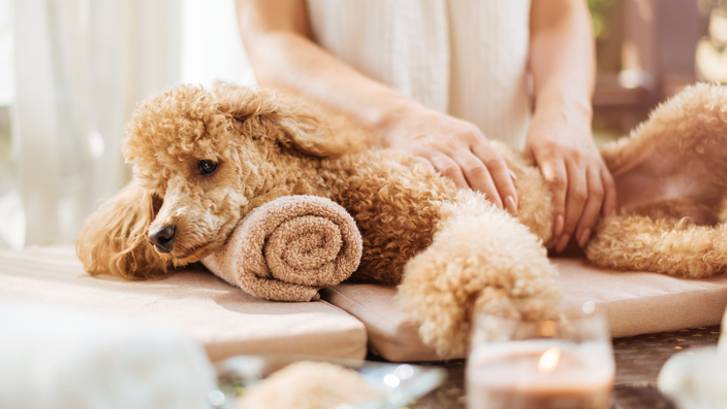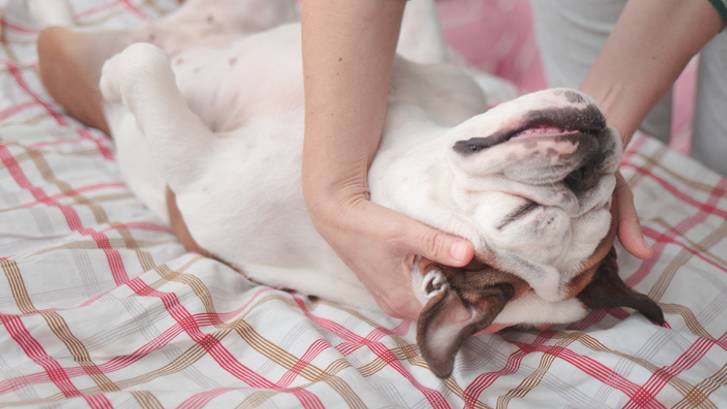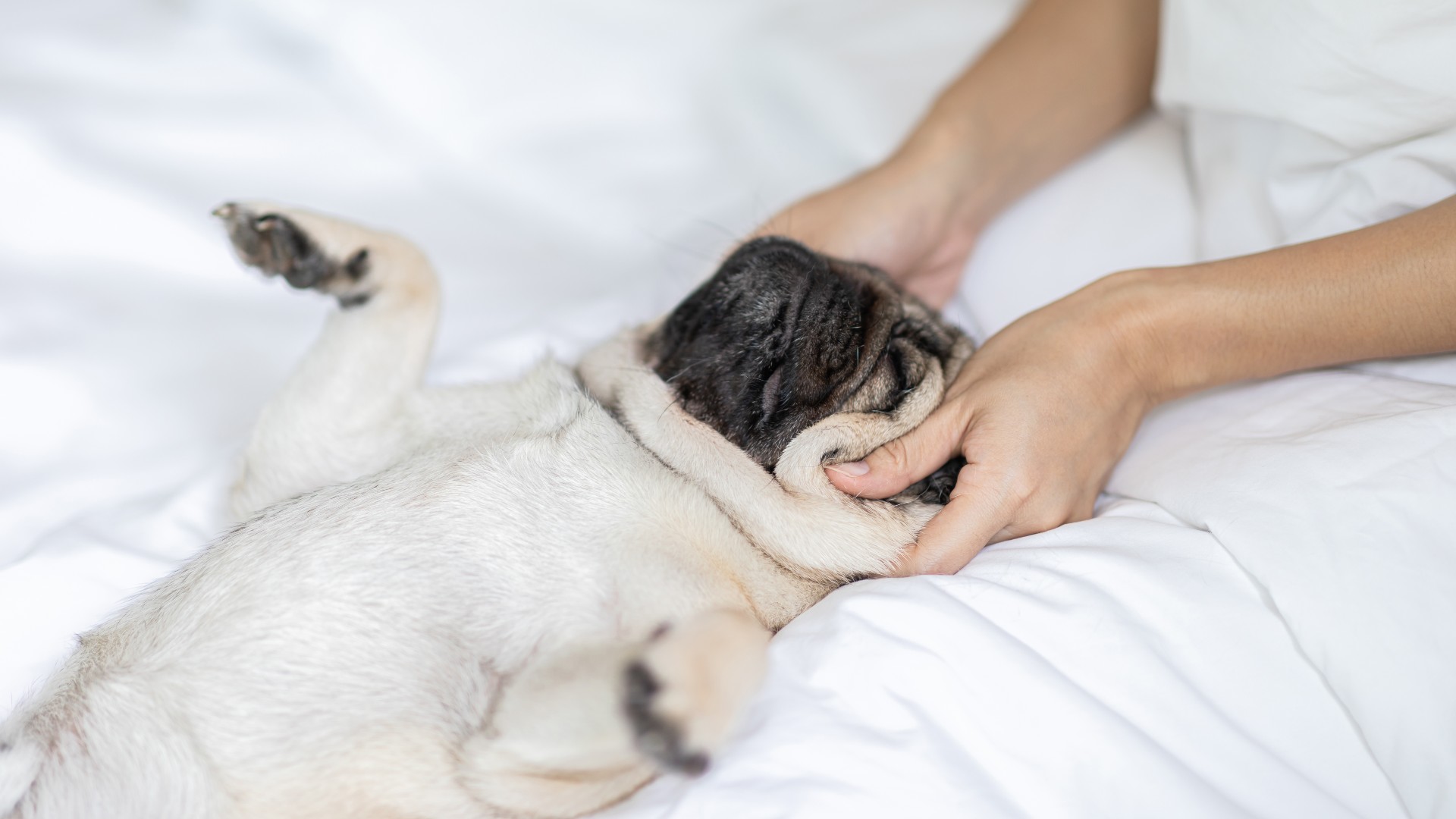How to massage a dog: When, why and what to do
Did you know that dogs can enjoy a massage too? But is it beneficial to massage a dog? Let’s find out!

Many of you will have experienced the tranquil sense of relaxation after a good massage. But can and should you massage a dog?
Several studies in humans have provided some evidence that massage can be beneficial for certain types of pain. While more studies are needed in both humans and animals, there is evidence that, if used correctly, massage can have beneficial effects on the muscles, circulation, nervous system, and mental wellbeing.
Whether your dog experiences anxiety or you'd simply like to strengthen your bond together, this guide will walk you through everything you need to know.
- Best calming dog beds: Perfect places for your pooch to relax
- Do calming treats for dogs work? A vet's opinion
- Dog depression: A vet's guide to symptoms, causes and treatment
Should you give your dog a massage?
Therapeutic (or clinical) dog massage refers to a massage that is being used as part of a treatment plan for a medical condition, such as osteoarthritis. For therapeutic massage to be safe and effective, it must be carried out by a certified canine massage therapist.
This is because it involves deeper tissue work and requires knowledge of anatomy, physiology, and biomechanics, to name a few. Therapeutic massage can cause more harm than good if performed incorrectly, so you should never attempt it at home.
If you would like to explore massage therapy for your dog, have a chat with your vet. They will be able to advise you whether massage is suitable for your dog, and also refer you to an appropriate clinical massage therapist.
However, there are some basic massage techniques that you can try at home with your pup! Basic dog massage can strengthen the bond between you, help your dog to relax, and help in between massage or physiotherapy sessions.

When to give your dog a massage at home
- If your dog is healthy and you would like to strengthen your bond
- If you have a dog with mild anxiety, who you feel would benefit from massage
- If your dog is having massage therapy or physiotherapy, and your therapist has taught you some massage techniques for home use
When should you not give your dog a massage?
- If your dog has a medical condition or injury
- If there is any chance that your dog might snap at you or bite you
- If your dog seems stressed or fearful during massage
If you’re interested in massaging your dog at home, it’s always sensible to have a chat with your vet first.
Dog massage benefits and drawbacks
Basic home massage can strengthen your bond with your dog and help your dog to feel relaxed. Massage also provides a good opportunity for you to check your dog for any lumps, bumps, or changes in their skin and coat. Of course, there are benefits for you too! It is well known that stroking pets has a positive impact on people’s mental health.
Naturally, the benefits of therapeutic dog massage can be even greater. These can include:
- Reducing pain in chronic pain conditions such as arthritis
- Rehabilitation of soft tissue injuries, alongside appropriate veterinary treatment
- Reducing swelling (inflammation) and fluid build-up (oedema)
- Improving mobility after periods of inactivity or long hospital stays
- Improving range of movement and flexibility
- Improving well-being and mood
Do dogs like being massaged?
Most dogs really enjoy a good massage, just as we do! Of course, all dogs are unique. Just as some people don’t like being touched, many dogs won’t either.
So, how do you know if your dog likes massage? If your pup is enjoying the experience they should be relaxed, stretched out, and sleepy.
If your dog isn’t keen, they may appear alert, keeping a close watch on you or the therapist. They will likely try to move away whenever they aren’t being touched. They will appear tense. They may even growl or snap. If this is the case, you should stop straight away. Never attempt to massage your dog if you risk being injured, or if your dog appears tense or distressed.
The good news is that many dogs can learn to enjoy massages, even if they don’t enjoy it at first. However, this takes time, patience, and a good knowledge of canine behavior.
If your dog doesn’t appear to enjoy massages and you wish to pursue it, then you should speak with your vet about referral to a certified clinical canine massage therapist.

How to massage a dog
Any deep soft tissue work, including kneading actions, should be left to the professionals! However, much like a baby massage at home, you can perform a gentle massage on a healthy dog at home.
- Firstly, it’s important that you only attempt to massage your dog when they, and you, are calm and relaxed. Choose a quiet area where your dog feels safe. Once your dog is used to you massaging them, you can try to use it when they seem worried, such as by fireworks.
- Start with a flat hand and use your palm to stroke your dog, working from the top of their head down. Use gentle pressure and start in the direction of hair growth. If your dog enjoys this, you can use a slightly firmer pressure. Always avoid bones and joints, so you’re only stroking over the muscles (for example either side of the spine).
- We all know how relaxing a scalp massage is! Most dogs also enjoy massage around the head. You can try rubbing from the nose to the back of the neck repeatedly. Your dog may enjoy the movement in both directions. Try gently rubbing their ears from the base to the tips.
When to consider professional massage therapy
Remember, you should only try a massage at home on a healthy dog. Massage is best left to the professionals in the following situations:
- Your dog has a medical condition or injury
- Your dog is in pain
- Your dog has recently had surgery
- Your dog has a tendency to snap or bite
If you wish to explore massage therapy in these situations, speak with your vet about referral to a certified or clinical massage therapist. As a rough guide, a certified therapist will charge around £40- £50 ($52 - $65) a session, depending on the massage therapy needed.
Conclusion
It’s a good idea to speak with your vet if you feel your pup could benefit from a dog massage. Massages at home can provide a great opportunity for bonding, leaving you and your pup feeling totally tranquil! If you do decide to have a go yourself, remember that you should only be performing basic stroking massage.
PetsRadar Newsletter
Get the best advice, tips and top tech for your beloved Pets
Sarah-Jane Molier graduated in 2009 and has been enjoying life as a vet ever since. She currently works as Head Veterinarian in a small animal practice. Sarah-Jane particular enjoys internal medicine, alongside her managerial role. When not working in practice Sarah-Jane enjoys sharing her knowledge and helping pet parents by writing on a wide variety of animal health and medicine topics. In her spare time Sarah-Jane loves walking Nero (her rescue dog), gardening with her two young children and reading.

